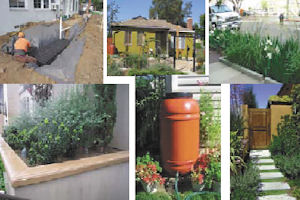Proposed rules to save water and decrease pollution have the Los Angeles building community worried the potential costs could stunt new development during uncertain economic times. Many Valley area developers are unfamiliar with the proposed Los Angeles city regulations. And others, while aware, are unsure of the impact the rules could have on their business and whether they would significantly add to their development costs. The proposed regulations, two years in the making, could saddle builders with costs ranging from $5,000 to $20,000 per unit for residential projects, said Holly Schroeder, chief executive of the Los Angeles and Ventura chapter of the Building Industry Association of Southern California. “We don’t like the idea of new regulations on the industry at a time of a bad economy,” Schroeder said. Storm water runoff — full of pollutants — typically flows off Los Angeles’s urban landscape and into the ocean. To buck the trend and recharge the aquifers, officials are pushing for building techniques that direct storm water into the ground by mimicking the natural environment through green landscaping. The ordinance is scheduled before the Los Angeles City Council in late September. If the rules pass, many new developments and some redevelopments would be required to capture, infiltrate or reuse all runoff from a ¾-inch rain storm. Builders could install a variety of green landscaping such as infiltration basins or permeable pavement to meet the mandates. Under existing storm water regulations, some large developments must currently employ these measures. The city’s bill would expand those rules to smaller projects while emphasizing managing runoff on site. ‘Too expensive to build’ Developer Rickey Gelb already is paying to manage runoff at his Canoga Park strip mall. Existing storm water regulations, other green building requirements, and the delays those caused, pushed rent up nearly 50 cents per square foot at the Shops at Vallarta, said Gelb, managing general partner of Encino-based Gelb Group: A Family of Companies. “With all the requirements, it just makes it too expensive to build and … you have a hard time passing it on to the tenants,” he said, explaining his project is only 75 percent full. Gelb said a storm water system that directs runoff into an underground gravel pit cost about $15,000, including labor. Future costs, he said, will be for upkeep and city compliance checks. With the economy struggling and regulations pushing up rents, Gelb said he is holding back from any new developments while he “digests” the Shops project. Rent is still too low, he said, to be turning a profit. Stuart Waldman, president of the Valley Industry & Commerce Association, said the increased costs incurred by developers will be passed down to tenants and consumers. “The money doesn’t come out of thin air,” Waldman said. He said expanding storm water rules could especially hurt the Valley’s many small developers and their projects, which employ thousands of people. “In many cases, they are making barely any profit at all, and any little fee adds on to make a project not worth doing,” said Waldman, whose organization is opposing the ordinance. City: ‘Impact will be very minimal’ City officials say fears about increased costs and their effects are over overblown. “The impact will be very minimal or nonexistent to developers,” said Adel Hagekhalil, assistant director of the city’s Bureau of Sanitation. “We will work with them to find how their projects can move forward.” Many large developments, Hagekhalil said, are already subject to the rules, and most of those wouldn’t see costs rise. Also, for the smallest residential developments under the proposed rules, only devices such as rain barrels or rain gardens would need to be installed. Costs for those projects would range from $800 to $1,300, he said. Overall, if the new rules pass, the development community is expected to see the cost to comply with storm water regulation rise between 5 percent and 10 percent, according to a joint-Chief Legislative Analyst and City Administrative Officer report released in December. Councilman Paul Krekorian said the rules are a “cost effective” way to decrease pollution, increase the region’s groundwater and lessen a reliance on costly imported water. “That is a great long-term benefit for everyone in Los Angeles, including the business community, because it reduces the overall cost of our water infrastructure,” Krekorian said. The councilman was part of a unanimous vote last year to have the city attorney draft the ordinance. But because the rules would only apply to new development and redevelopment, they could stilt new projects, while not affecting a large enough area to have significant environmental benefit, Schroeder said. The latest proposal comes after numerous meetings between the city and the business community to address concerns. Hagekhalil pointed to several changes fashioned to ease the impact on the business community: A mitigation fee was scrapped, a grandfather clause was crafted, enforcement would be delayed, a “menu” of options for the complexity of development in Los Angeles was made available and more. If a project is unable to direct runoff into the ground, he said, other options can be employed. Those include saving the water for reuse, filtering it, or paying for offsite measures within the same vicinity. Anne Williams, vice president of legislative and legal affairs for the Central City Association, said those options will make it easier for dense, urban projects — without significant space for landscaping — to meet the rules. “This started out as a one-size-fits-all ordinance,” she said. “It is much improved.” If the ordinance passes, as expected, Schroeder said she doesn’t want the conversation to stop. “We appreciate the steps to make it easier, but we still think it will be very difficult to be compliant, and we want to continue to work with the city.”
